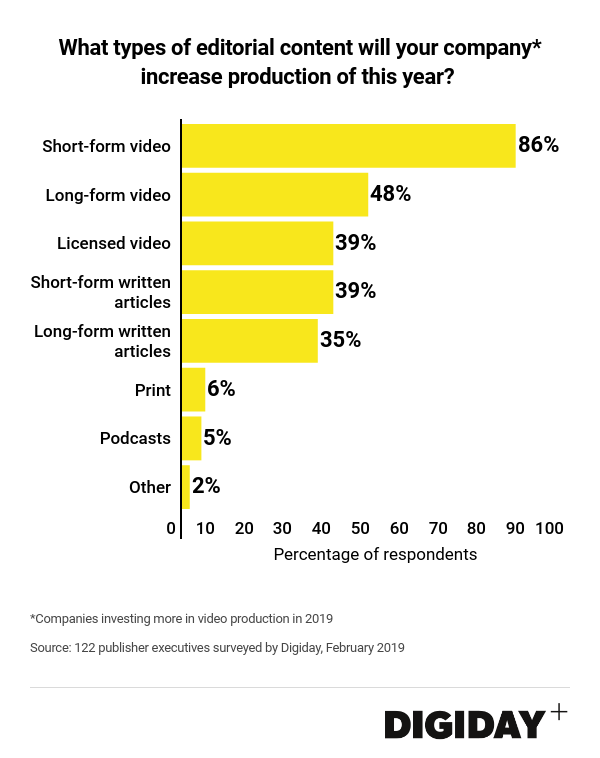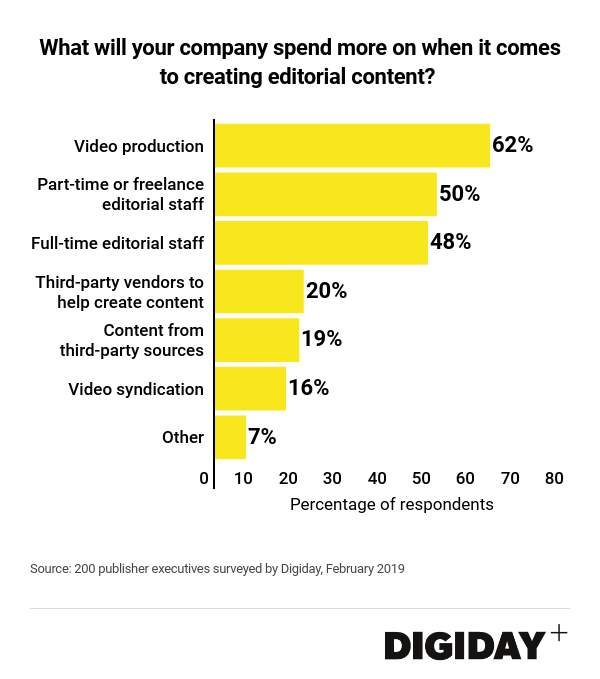Save 50% on a 3-month Digiday+ membership. Ends Dec 5.
Digiday Research: 62 percent of publishers plan to spend more on video production
This research is based on unique data collected from our proprietary audience of publisher, agency, brand and tech insiders. It’s available to Digiday+ members. More from the series →
The pivot to video might be over, but publishers are still prioritizing short-form video.
Earlier this month, Digiday polled 200 publishers and found that 86 percent of publishers increasing their video production budgets said they will produce more short-form video content compared to just 48 percent of publishers who said they would make more long-form videos and 39 percent who said they would make more videos to license out to OTT and TV platforms.
Short-form video content, which can still perform well on platforms like Instagram or YouTube, appeals to publishers for its ability to generate awareness for new products and build audiences. It is also vastly cheaper too.

Overall, 62 percent are increasing spending on video, 50 percent said they will fund more freelance and part-time editorial staff and 47 percent will increase budgets for full-time editorial staff.

Ad position: web_incontent_pos1
Meanwhile hiring part-time or freelance editorial employees might be a cheaper way for publishers to meet growing content demands. Companies like BuzzFeed, Fortune and Forbes have long relied on freelance contributors to help meet those demands. But it also leads to unrest among full-time staff worried about being replaced and a growing push to unionize. Bustle Digital Group found itself under pressure after unionized staffers, laid off after the sale of Mic to BDG, claimed that their unfinished work was completed without their consent by Bustle employees.
However, the small likelihood that publishes will hire for part-time or freelance editorial staff over full-time staff could just be the result of current market forces. With low unemployment rates, research from Edelman Intelligence in June and July of 2018 found that the majority of freelancers do so voluntarily.
Though video burned publishers who adopted platform-reliant strategies, many have created thriving and sophisticated video strategies. Complex turned video licensing into a “high eight-figure” business by working with Netflix, Hulu and other partners. The Hill, which is prioritizing its video capabilities ahead of subscriptions, learned from the past mistakes of others and does not rely on a single platform to generate the majority of its audience.
Mindbodygreen, a health and wellness based company, is expanding video production on its owned channels. The company now sells 80 video courses focusing on topics like yoga, nutrition and meditation to consumers from its own site.
“Almost all of the focus has been putting the best content on our owned and operated platform,” said Colleen Wachob, co-founder and co-CEO of Mindbodygreen. “There is a huge disconnect between the high-quality video content that does well on our site and the viral video content that does well on social platforms.”
More in Media

What publishers are wishing for this holiday season: End AI scraping and determine AI-powered audience value
Publishers want a fair, structured, regulated AI environment and they also want to define what the next decade of audience metrics looks like.

Digiday+ Research Subscription Index 2025: Subscription strategies from Bloomberg, The New York Times, Vox and others
Digiday’s third annual Subscription Index examines and measures publishers’ subscription strategies to identify common approaches and key tactics among Bloomberg, The New York Times, Vox and others.

From lawsuits to lobbying: How publishers are fighting AI
We may be closing out 2025, but publishers aren’t retreating from the battle of AI search — some are escalating it, and they expect the fight to stretch deep into 2026.
Ad position: web_bfu
